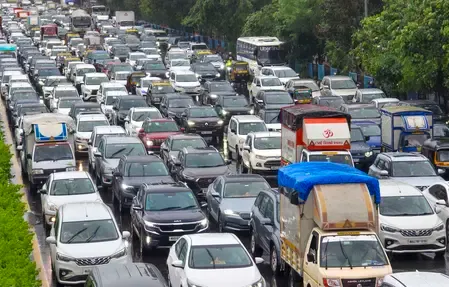How Did India's Vehicle Sales Surge 4.84% in June?

Synopsis
Key Takeaways
- India's vehicle sales grew by 4.84% in June 2023.
- Total sales surpassed 20.03 lakh units.
- Positive growth was seen across all segments.
- Challenges include financing constraints and variant shortages.
- Cautious optimism is the outlook for the upcoming months.
New Delhi, July 7 (NationPress) Total automobile retail sales in India surged by 4.84 percent year-on-year in June, surpassing 20.03 lakh units. This growth was fueled by demand during the festival and marriage seasons, according to the Federation of Automotive Dealers Associations (FADA).
"Every segment reported positive growth, with two-wheelers increasing by 4.73 percent, three-wheelers by 6.68 percent, passenger vehicles by 2.45 percent, commercial vehicles by 6.6 percent, tractors by 8.68 percent, and construction equipment by an impressive 54.95 percent," stated FADA president C.S. Vigneshwar.
"While the festival and marriage seasons provided an impetus, financing issues and sporadic shortages of variants tempered overall sales. The early monsoon rains and the rising penetration of electric vehicles (EVs) also influenced buying trends,” he elaborated.
“June showcased a resilient performance in the two-wheeler segment amidst mixed market indicators," Vigneshwar added.
Although passenger vehicle sales dropped by 1.49 percent month-on-month, they still recorded a 2.45 percent increase year-on-year. "Heavy rainfall and tight market liquidity affected foot traffic and sales conversions, even as attractive incentive schemes and new bookings provided some support. Certain passenger vehicle manufacturers have implemented mandatory billing practices, such as automatic wholesale debits, to achieve volume targets; thus, inventory remains at approximately 55 days. June depicted a picture of modest yet consistent performance in the passenger vehicle sector amidst varied market signals," Vigneshwar explained.
Commercial vehicle sales experienced a 2.97 percent decline month-on-month but achieved a solid 6.6 percent year-on-year growth. Vigneshwar noted that early-month deliveries boosted volumes before the monsoon-induced slowdowns and limited liquidity affected inquiries and conversions.
"Members pointed out the influence of new commercial vehicle taxes and mandatory air-conditioned cabins, which have increased ownership costs, alongside subdued infrastructure demand. Overall, June highlighted a resilient commercial vehicle segment successfully managing cost pressures and a softening economy," he detailed.
FADA anticipates that July will bring mixed outcomes influenced by agricultural tailwinds and the return of schools, yet tempered by seasonal challenges, high price points, and liquidity issues.
"Dealer sentiment seems to lean towards expectations of stagnation or decline (42.8 percent and 26.1 percent) surpassing those anticipating growth (31.1 percent).
In the two-wheeler sector, early monsoon rains and renewed rural activity have sparked interest, though heavy rainfall, variant shortages, and impending price hikes in July are hindering conversions.
Passenger vehicles are grappling with high base effects, limited new model introductions, and tight financing, partially offset by festival preparations and new incentive schemes. Commercial vehicles continue to struggle with subdued infrastructure demand and increased ownership costs due to new taxation and mandatory AC cabin regulations, although extended order pipelines offer some relief.
Looking ahead, FADA has taken a stance of cautious optimism, leveraging rural demand drivers and government capital expenditure while remaining adaptable to navigate disruptions caused by the monsoon, supply constraints, and liquidity pressures.









